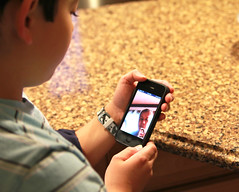
It seems a no-brainer that the internet, social media, and cellphones have made homesickness for migrants a thing of the past. But as historian Susan J. Matt reveals in a recent New York Times op-ed, previous generations have found technology no substitute for home sweet home, and today’s immigrants are no different.
More than a century ago, the technology of the day was seen as the solution to the problem. In 1898, American commentators claimed that serious cases of homesickness had “grown less common in these days of quick communication, of rapid transmission of news and of a widespread knowledge of geography.”
But such pronouncements were overly optimistic, for homesickness continued to plague many who migrated.
Today’s technologies have also failed to defeat homesickness even though studies by the Carnegie Corporation of New York show that immigrants are in closer touch with their families than before. In 2002, only 28 percent of immigrants called home at least once a week; in 2009, 66 percent did. Yet this level of contact is not enough to conquer the melancholy that frequently accompanies migration. A 2011 study published in the Archives of General Psychiatry found that Mexican immigrants in the United States had rates of depression and anxiety 40 percent higher than nonmigrant relatives remaining in Mexico. A wealth of studies have documented that other newcomers to America also suffer from high rates of depression and “acculturative stress.”
Then why does the idea that technology can overcome homesickness persist? Matt cites a pervasive belief about mobility that many hold despite its disappointments.
The global desire to leave home arises from poverty and necessity, but it also grows out of a conviction that such mobility is possible. People who embrace this cosmopolitan outlook assume that individuals can and should be at home anywhere in the world, that they need not be tied to any particular place. This outlook was once a strange and threatening product of the Enlightenment but is now accepted as central to a globalized economy.
Technology plays a role in supporting this outlook.
The comforting illusion of connection offered by technology makes moving seem less consequential, since one is always just a mouse click or a phone call away.
Further, Matt argues that this illusion of connection may amplify homesickness rather than cure it.
The immediacy that phone calls and the Internet provide means that those away from home can know exactly what they are missing and when it is happening. They give the illusion that one can be in two places at once but also highlight the impossibility of that proposition.
The persistence of homesickness points to the limitations of the cosmopolitan philosophy that undergirds so much of our market and society. The idea that we can and should feel at home anyplace on the globe is based on a worldview that celebrates the solitary, mobile individual and envisions men and women as easily separated from family, from home and from the past. But this vision doesn’t square with our emotions, for our ties to home, although often underestimated, are strong and enduring.

Comments 2
Stephen Ransom — May 2, 2012
I think this is quite true. Intimacy and a sense of "home" requires more than a Skype call, phone call, text, or email message. It helps, but it doesn't conquer our physical need of intimacy and proximity. I have had friends living abroad who have skyped into Christmas dinner to be with family, and it was nice, but if anything, as the above quotation expresses, it generated a desire for greater proximity and intimacy and amplified the distance between them. As depicted in the photo above that you have used, my children Skype with their grandparents in the Philippines almost daily. It IS a nice way for their grandparents to interact at such a distance. My children play their instruments for them, share events with them, and my grandparents show them the exotic things that they are eating... It's fun. But - it's no replacement for being in the kitchen with them, talking to them, watching them, hugging them, truly being present...
You might be interested in reading/listening to Sherry Turkle, a researcher from MIT and director of the MIT Initiative on Technology & Self and most recently, author of , Alone Together: Why We Expect More From Technology and Less From Each Other. Here is her TED Talk titled, "Connected, but alone."
http://www.ted.com/talks/sherry_turkle_alone_together.html
Letta Page — May 2, 2012
Thanks so much, Stephen! Your photo was perfect for the piece, and the backstory adds so much. Much of Turkle's research has been looked at in our Community Page Cyborgology (www.thesocietypages.org/cyborgology), and you might find the discussions there really interesting! Again, thanks for using creative commons for your photo.